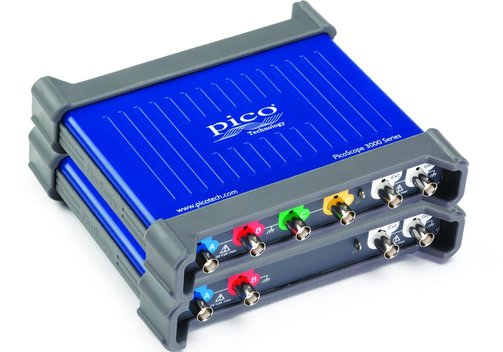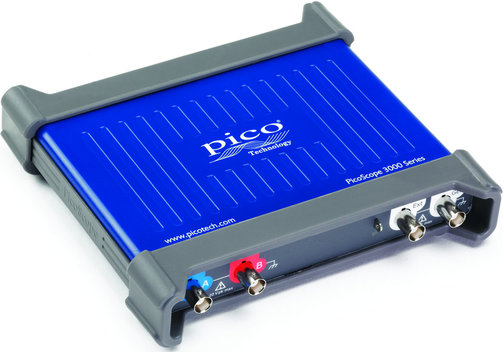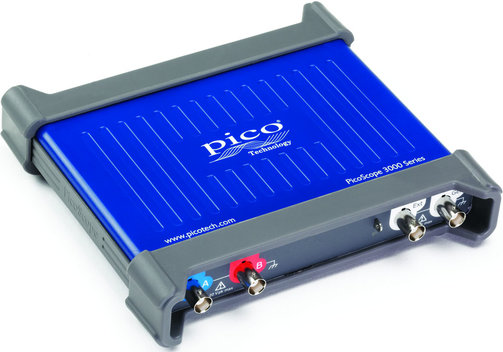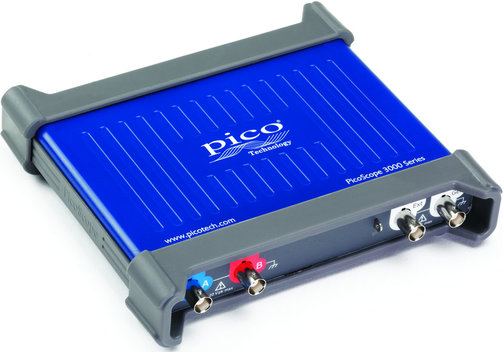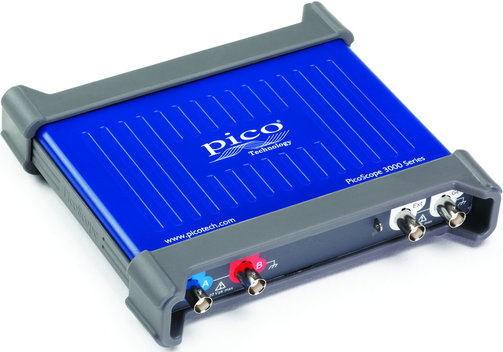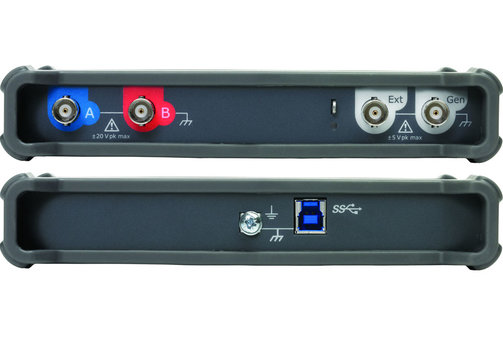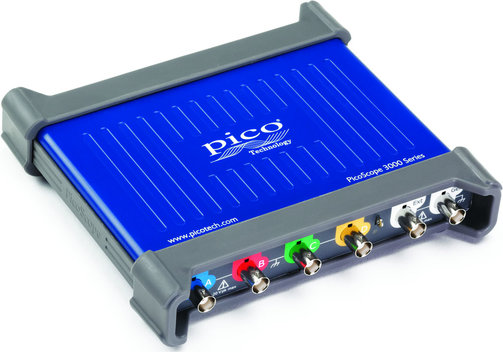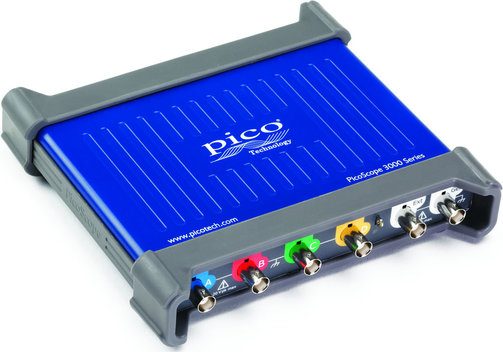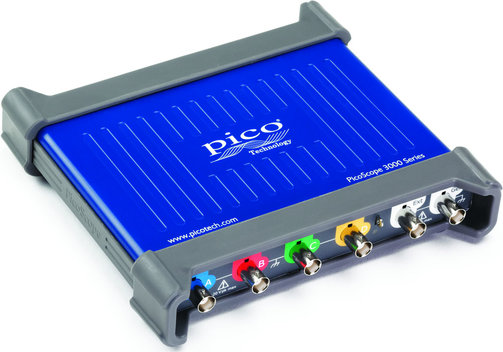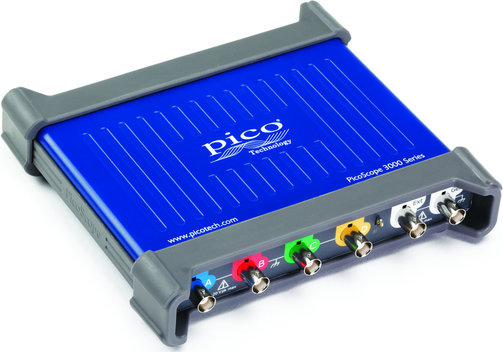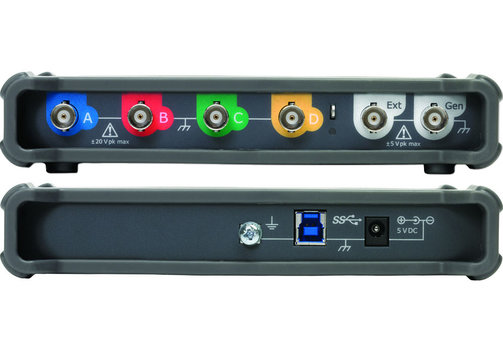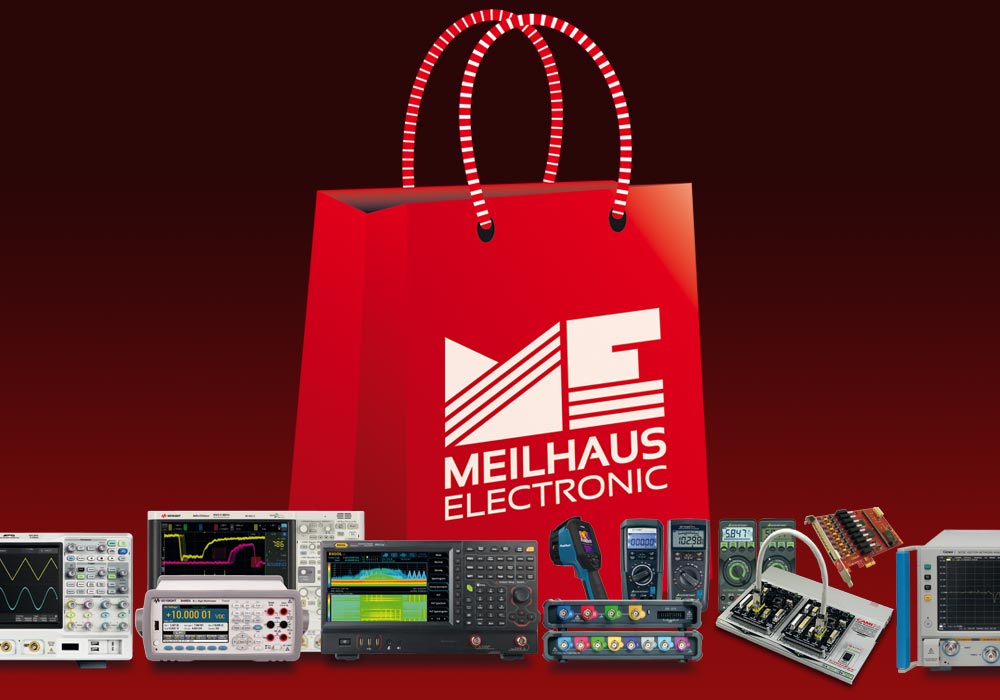PicoScope 3000 Series USB PC Oscilloscopes, 2/4 Channels, up to 200MHz
Benefits of the PicoScope PS3000 Series - All-round Oscilloscopes for General Purpose Applications
- USB PC oscilloscope allrounders with 2 or 4 channels.
- Bandwidths up to 200 MHz.
- Deep memory up to 512 MS.
PicoScope3000 Series USB PC Oscilloscopes, 2/4 Channels, up to 200 MHz
Models PicoScope PS3203D, PS3204D, PS3205D, PS3206D, PS3403D, PS3404D, PS3405D, PS3406D
The PicoScope 3000 series are 2 and 4-channel USB PC oscilloscopes with bandwidths from 50 to 200 MHz and maximum sample rates up to 1 GS/s. The oscilloscopes are the modern alternative to bulky desktop devices and are suitable as true all-rounders for many applications from laboratory to embedded. The proven ▸PicoScope7 software is packed with professional features such as math, statistics, automatic measurements, advanced triggering, mask testing or serial bus decoding.
- 2 or 4 analog channel.
- 50, 70, 100, or 200 MHz bandwidth.
- 1 GS/s max. sampling rate (1 channel).
- Memory depth, depending on model, between 64 MS and 12 MS.
- Function generator/signal generator and arbitrary waveform generator/AWG included, bandwidth 1 MHz.
- Incl. the versatile ▸PicoScope7 software for Windows, Linux, Mac, as well as the SDK/software developer kit for programmers/developers:
- Versatile mathematics, statistics, automatic measurement and advanced triggering included.
- Mask testing included.
- Serial bus-decoding included for various protocols, including 1-Wire, ARINC429, CAN/CAN-FD, BroadR-Reach (100BASE-T1), DALI, DCC, DMX512, Ethernet 10Base-T/100Base-TX, FlexRay, I²C, I²S, LIN, PS/2, Manchester, MODBUS, SENT, SPI, UART (RS232/RS422/RS485), USB 1.1.
- Spectrum analyzer function included.
- All models for USB 3.0 (compatible with 2.0).
- Depending on model USB-powered or external AC power adaptor.
Model Overview
| Model | PicoScope 3203D | PicoScope 3204D | PicoScope 3205D | PicoScope 3206D | PicoScope 3403D | PicoScope 3404D | PicoScope 3405D | PicoScope 3406D | |
| PP958 (EOL/obsolete) | PP959 (EOL/obsolete) | PP960 | PP961 | PP962 | PP963 | PP964 | PP965 | ||
| Channels | Analog | 2 | 2 | 2 | 2 | 4 | 4 | 4 | 4 |
| Digital | - | - | - | - | - | - | - | - | |
| Bandwidth | 50 MHz | 70 MHz | 100 MHz | 200 MHz | 50 MHz | 70 MHz | 100 MHz | 200 MHz | |
| Sample rate | 1 analog channel (all): 1 GS/s | ||||||||
| 2 analog channels (all)): 500 MS/s | |||||||||
| 4 analog channels (all)): 250 MS/s | |||||||||
| more than 4 analog channels: 125 MS/s | |||||||||
| Memory depth | 64 MS | 128 MS | 256 MS | 512 MS | 64 MS | 128 MS | 256 MS | 512 MS | |
| Resolution | 8 bit | ||||||||
| Serial decoding | Supports a variety of protocols, including 1-Wire, ARINC 429, CAN, CAN FD, DALI, DCC, DMX512, Ethernet 10Base-T and 100Base-TX, BroadR-Reach/Ethernet 100Base-T1, FlexRay, I²C, I²S, LIN, Manchester, PS/2, MODBUS, SENT, SPI, UART (RS232/RS422/RS485), USB 1.1 | ||||||||
| More features | Spectrum analyzer (DC to scope bandwidth), math channels, automatic measurements, mask limit test, advanced trigger | ||||||||
| Signal gnerator | DC...1 MHz. ±2 V. Sine, square, triangle, DC; rampe up/down, sinc, Gauss, halfsine, white noise, PRBS; AWG 20 MS/s, 12 bit, >1 MHz, buffer: 32 kS | ||||||||
| Interface | USB 3.0 SuperSpeed (compatible with 2.0) | ||||||||
| Power supply | USB bus-powered | External ower supply | |||||||
Included: USB oscilloscope from the PicoScope 3000 series (PS3203D, PS3204D, PS3205D, PS3206D, PS3403D, PS3404D, PS3405D, or PS3406D), ▸PicoScope7 software and user manual (download), USB cable, 2x or 4x switchabel x1/x10 probes. 4-channel models: Power supply adaptor.
Frequently Asked Questions:
Question: What software is included with the PicoScopes?
Answer: All PicoScopes (except sampling scopes, SXRTO and automotive models) work with the same software. This is available via free download from the manufacturer's website.
- The major part is the PicoScope-Software for Windows, a PC oscilloscope software as well as complete test and measurement lab. The software includes standard features such as oscilloscope, spectrum analyzer, advanced triggers, automatic measurements, interactive zoom, persistence modes, math channels, mask tests, serial bus decoding and analysis, and signal generator control.
- In addition, beta versions of the PicoScope software are available for Linux and macOS.
- The PicoScope Software Development Kit (SDK) is the "toolbox" for developers to write their own software for the oscilloscopes. The SDK includes drivers for Windows, macOS and Linux (including beta versions for Raspberry Pi and Beaglebone). Sample code explains how to interface with third-party software packages such as Microsoft Excel, National Instruments LabVIEW, and MathWorks MATLAB, and programming languages such as C, C++, C#, or Visual Basic .NET..
Learn more about the ▸PicoScope7 software.
Question: What operating systems does the PicoScope software support?
Answer: PicoScope6 software runs fully on Microsoft Windows (recommended versions 7, 8, and 10 - as of April/2021). PicoScope for Linux and macOS are beta versions or may not support the full functionality of the devices. PicoScope for Linux runs under Debian 7.0, Ubuntu 12.xx and 13.xx and other Debian-based distributions with the Mono Runtime 2.10.81 (drivers are available for PicoScopes 2000 to 6000). PicoScope for macOS supports the versions 10.9 and 10.10. If in doubt, talk to our support team!
Question: I want to buy an oscilloscope - what bandwidth should I choose?
Answer: The bandwidth (BW) provides information about the frequency range of the oscilloscope. Mostly the upper cut-off frequency in Hertz or max. frequency of an applied signal is quoted, at which the signal amplitude is represented with a fixed attenuation 3 dB/gain -3 dB. The bandwidth thus determines which signals (with respect to their frequency) can be measured and displayed with the oscilloscope within a certain accuracy. For example, an ideal 100 MHz square wave signal consists of a 100 MHz sine wave and an infinite number of odd harmonics. Therefore, a much higher bandwidth is needed for measurement. When selecting an instrument, the frequency (F) of the signal to be measured serves as a criterion. A simple rule of thumb: For a digital signal, use a bandwidth that is at least 5x higher than your fundamental frequency to be measured. For an analog signal, use a bandwidth that is at least 4x to 5x higher than your fundamental frequency to be measured.
Information on product safety:
Manufacturer:
Pico Technology Ltd., James House, Colmworth Business Park, St Neots, Cambridgeshire, PE19 8YP/GBR
www.picotech.com
Responsible person:
Meilhaus Electronic GmbH, Am Sonnenlicht 2, 82239 Alling/DEU
info@meilhaus.com
Related Products
Customers also bought
























